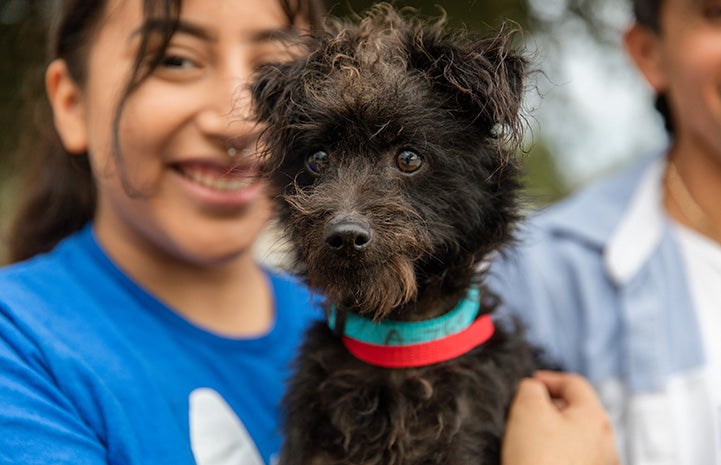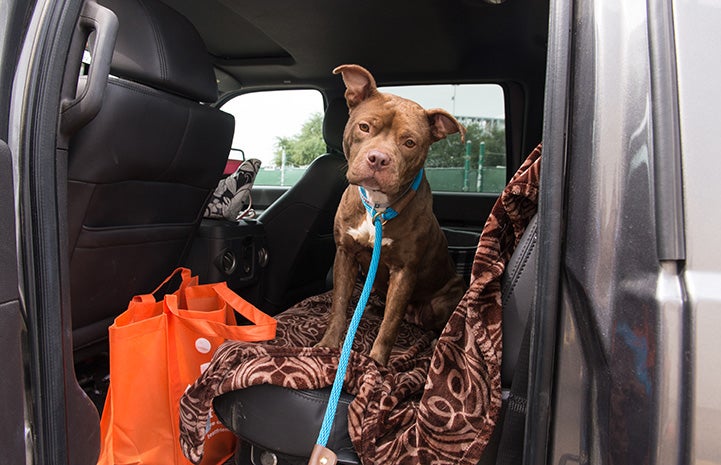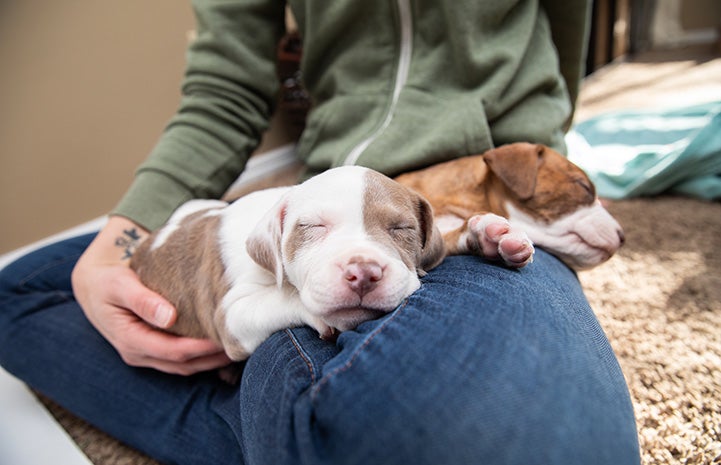Saving the lives of animals through community-supported sheltering

Before the COVID-19 pandemic, Lafayette Animal Shelter in Louisiana did not have a foster program in place for any animals other than neonatal kittens. Then came the pandemic and the urgency to move pets out of shelters and into homes as quickly as possible in anticipation of shelter buildings closing to the public. And that’s when something amazing happened.

A fostering “aha” moment
After calling on community members for help, the lifesaving team in Lafayette moved more than 50 pets into foster homes and began providing support for fostering and adoption virtually. Once they did that, they discovered just how engaged members of the public were in the fostering and adoption process. “COVID-19 propelled us to do what we always wanted to,” says Shelley Delahoussaye, the supervisor at Lafayette Animal Shelter. “Our community stepped up and we quickly realized that foster homes were either adopting their foster pets themselves or getting videos and pictures of the pets and sharing them on social media.”
Shannon Wells, the executive director at Lawrence Humane Society in Kansas, concedes that, although staff knew they needed one, her shelter had also done little to nothing with their foster program before the coronavirus crisis. But once they observed how quickly community members responded to their plea for help, allowing 90% of the pets in the shelter’s care to be moved into foster homes, the staff realized the untapped lifesaving potential of their community. Shannon notes, “This forced us out of a rut and into creative out-of-the-box thinking.”
The staff at South Suburban Humane Society in Chicago had a similar epiphany. “This has allowed us to open up a whole new world where foster families can be really engaged,” explains CEO Emily Klehm. “Adoption counselors are now adoption facilitators between people who love that pet (in foster homes) and people who want to love that pet (in adoptive homes).”
[The joy of fostering a shy dog during COVID-19]

An invitation to help save lives
While the COVID-19 crisis in early March served as the catalyst for many shelters to turn to the public for help, this move toward reimagining the lifesaving process to be more community- supported has been the goal for much longer. And the focus on revamping the way shelters do their work goes way beyond foster programs. Today, calls for more community-centered and community-supported sheltering models are all about finding the best possible outcome for pets by inviting members of the community to participate in the lifesaving process rather than cutting them out of it. And the invitation piece is key.
For so long, many shelters have simply been afraid or reluctant to ask their communities for help. That reluctance has led to communities being unaware of the challenges (or in many cases, the crises) their shelters are facing, leaving individual community members unprepared to help save animals and solve problems. Typically, when a member of the public finds a litter of kittens or encounters a dog who appears to be lost, the immediate response is to call animal control or bring the animals to the shelter and let the already overworked staff take over from there.
Shelter budgets then become singularly focused on the number of animals entering shelters and the need to physically care for and house animals rather than on more effective metrics such as a municipality’s human population size and the types of resources that might be lacking (for example, spay/neuter services, support for community cat caregivers and pet-inclusive housing). By inviting their communities into the lifesaving process, shelters are daring to imagine a better world for pets in need and creating opportunities for people to help shape that world.

Thinking beyond the brick-and-mortar building
Shelters are now envisioning what’s possible for homeless dogs and cats when we think beyond the concept of sheltering as four walls and a roof. When we focus on a physical structure or building rather than an idea, we box in our thinking, literally.
After closing animal admissions at Hillsborough County Pet Resource Center in Florida for all non-urgent cases in response to the pandemic, director Scott Trebatoski says the number of animals normally entering the shelter between March and May dropped by around 2,000. Instead of spending time cleaning hundreds of kennels and providing basic care for all those animals, the staff transitioned to roles like adoption facilitators, for both foster volunteers and potential adopters, and case managers for community members who find stray animals or who need help with their own pets.
“We coached people on how to use Nextdoor.com and gave them our online tool for printing posters for found pets,” says Scott. “Typically, we’ve found that the (people) who don’t find the owner for a lost pet want to keep the pet when we call them to follow up. We’re so confident we’ll keep our numbers down that we’re cutting doors between kennels to open up space for better care and reduce capacity.”
[10 good news stories from animal shelters during COVID-19]
Orange County Animal Services, located northeast of Hillsborough, had been piloting a new neonatal kitten diversion program a few months before COVID-19 hit. The communications platform, which is called Wait ’Til 8, is designed to empower citizens to keep and care for orphaned kittens, who would typically not survive in the shelter until they’re old enough to be adopted.
As Nick Lippincott, the special programs and training coordinator, explains, “The platform provides them with some statistics up front and allows us to basically explain that we need you to make this happen — otherwise, these animals won’t survive.” During the pilot phase, according to Nick, of the 190 or so community members who used the Wait ’Til 8 system for kittens they found, “98% of those people chose to help and care for the kittens themselves at home using the resources we gave them.”

More transparency and trust, less panic
What shelters like the ones in Hillsborough and Orange counties are realizing is that investing in lifesaving solutions that take place outside of the physical shelter frees up large amounts of time, energy and money. Those resources can then be used for things like technology to support virtual counseling between staff and community members, mentoring for kitten and cat caregivers, food and supplies for local pets, advanced training for dogs who need intensive behavioral support, and equipment and vehicles for local cat groups.
[Delivering pet food in the New Orleans area to those in need]
Just as important, opening up the lifesaving process to include the community and moving it beyond the shelter walls creates more transparency and builds more trust between shelter staff and the community’s residents. It also creates a more enjoyable, productive and sustainable work environment for people who do work in the shelter.
In this new world of animal welfare, says Alexis Pugh, director of Memphis Animal Services, “we don’t have to live in a constant state of panic and crisis. Doing this (involving the community in saving lives) doesn’t make us lazy or less productive. It makes us more responsible from a lifesaving perspective and a fiscal perspective, and it gives us an opportunity to finally do the one thing that is actually going to fix this problem, which is not putting animals into kennels. It is helping people with animals at their homes.”

Engaging the whole community
Animal shelters are not, and never should have been, a physical “drop box” for dogs and cats. Pets are part of our families, part of our communities. That means caring for them and keeping them safe is our collective responsibility.
In a community-driven sheltering model, networks of service providers (spay/neuter groups, trap-neuter-return teams, rescue groups, veterinarians, community cat caregivers, dog walkers, local businesses, neighborhood groups, animal control officers and shelters) work together to save and support pets and people, rather than letting that responsibility fall solely on shelters. Those collective efforts also hinge on inviting everyone to the lifesaving party.
[Stories from first-time pet foster volunteers]
If our goal is to create compassionate no-kill communities nationwide, everyone needs to be involved in that process. Those of us working and volunteering in animal welfare need to reach out to individuals, organizations, businesses and neighborhoods historically excluded from our field. We can’t solve a community-based problem while leaving out parts of the community. That’s the true meaning of the word “together” in “Together, we will Save Them All.”
In addition, the lifesaving data we’re collecting right now should be based on the whole community. Rather than simply looking at data for individual shelters, we need to move toward capturing the lifesaving that is happening community-wide in order to paint a complete no-kill picture.
As a community member, you are part of that picture, so if you haven’t done it already, check out Best Friends’ pet lifesaving dashboard to see what’s happening in your community and state. You can participate in saving lives by joining or creating a 2025 Action Team, or reaching out to your local shelter and animal groups on your own.
Shelters all over the country are beginning to embrace the power of community-supported lifesaving. And as we work to support them in that endeavor, let’s also make sure that the response they get to the question “Can you help?” is a resounding “Yes, absolutely!”

Save lives in your community
Want to know more about what’s happening and how to save lives in your community? Check out the pet lifesaving dashboard and learn about joining a 2025 Action Team.
Read more:
Strut Your Mutt 2020 goes virtual from coast to coast
Pet portraits draw laughs, raise dollars for pets
Virtual pet meet-and-greets open doors to new families
This article originally appeared in Best Friends magazine. You can subscribe to the magazine by becoming a Best Friends member.
Photos by Erica Danger, Molly Wald, Sonya Sellers and Sarah Ause Kichas